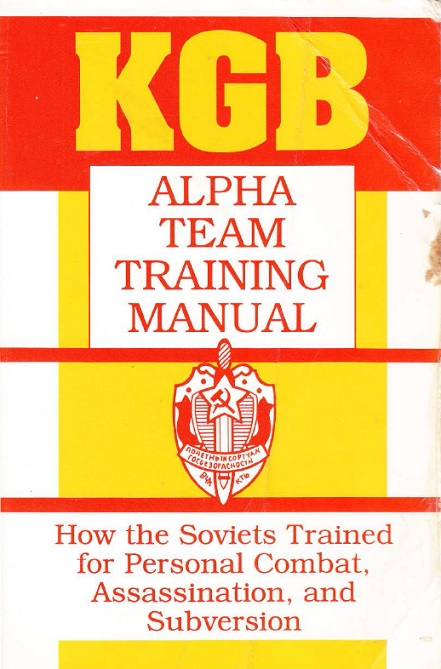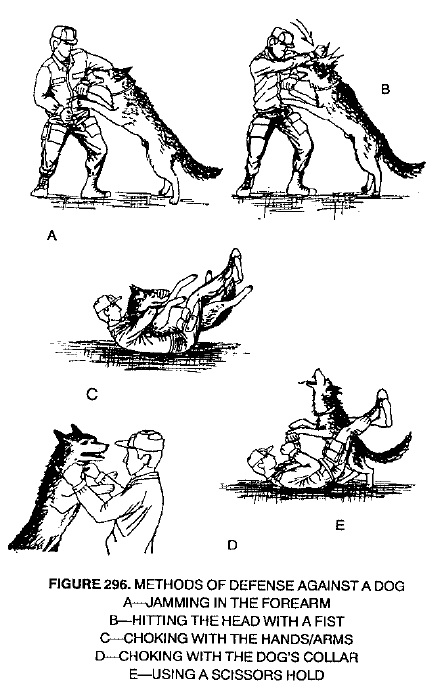
KGB Alpha team training manual
How the soviets trained for personal combat, assassination, and subversion
The KGB Alpha Team Manual was written by A. I. Dolmatov, the chief instructor at the Dynamo sports center in Moscow. Ask any former USSR official what Dynamo was and he would answer, "Just a sports club. Policemen used it." Ask any Western sovietologist and he would add that Dynamo existed in every major Soviet city and was dominated by the KGB and MVD (Soviet Interior Ministry). It was not your usual after -work health club.
Completed in 1989, The KGB Alpha Team Manual borrowed heavily from the 1945 standard Spetsnaz text on reconnaissance, transportation, physical conditioning, personal combat, building entry, and prisoner acquisition. However for KGB Alpha Team usage, Dolmatov added major sections on assassination, sabotage, countersubversion measures, and snatching citizens off the streets - both inside and outside the USSR. Illustrations of Spetsnaz killing U.S. Special Forces and 1st Cavalry personnel accompanied the instructions.
Now exclusively from Paladin Press, this manual is available for the first time outside the former Soviet Union. The English-language translation includes illustrations and tactics championed by the KGB, as well as an introduction by Jim Shortt, who trained numerous Western military and police security forces in anti-Spetsnaz tactics and in 1989 became the first Westerner to train Soviet military personnel in counterterrorist measures.

Editor's note:
The KGB Alpha Team Training Manual was provided to Paladin Press by Jim Shortt, who, as director of International Bodyguard Association (IBA), has trained numerous Western military and police units in anti-Spetsnaz activities. Shortt was the first outsider to train KGB personnel, and he has been active in the Baltic States both before and after independence, training these republics' police and security forces. Shortt also trained mujahideen forces during the war in Afghanistan.
Several pages in chapters 5 and 6 of this manual are missing. The same pages were missing in every copy of the manual that Shortt examined. This leads one to believe that the pages were either deliberately pulled because of sensitive information found on them, or the Soviet military suffered from the same inefficiency as bureacuracies everywhere and the pages were inadvertently left out of the original printing. The places with missing text have been footnoted.
In the following, Shortt briefly examines Soviet special operations to show the relationship of various organizations and to document how the information contained in the manual was used by the KGB, GRU, MVD, and other "special assignment units." He also includes some personal accounts of his training missions in various Soviet republics to illustrate how many of the functions formerly performed by the KGB and GRU are now being assumed by police units in the various republics or local mafia groups.
I was sitting in a small apartment in the Latvian capital of Riga in January 1992 with members of the Latvian Security Service's bodyguard department. Between us we were - as the Irish in me would say - doing justice to a goodly number of bottles of Kristal Dzidrais, Latvian vodka, and melnais balzams, a potent tarlike local liquor. Our host, a major with the service, had been in his time a graduate and later instructor at the Soviet Defense Intelligence (GRU) #4 Spetsnaz Brigade based near the Estonian town of Viljandi.
While the snow and minus - 16 - degree temperature kept the Latvian vodka-in-waiting correctly chilled, I pored over the photograph album of my host and mused that it was, in many ways, similar to my own. Although the uniforms and equipment were different, the scenarios were similar. When I came to the training manuals used by the Soviet Spetsnaz, I noticed that they were surprisingly few and all written in 1945 by veterans of the partisan units, OSNAZ Brigade, and Reconnaissance Scouts. Their primary emphasis was on physical capability, daring, and conditioning.
Next, I looked over more recently produced close-quarter-battle (CQB) manuals from the army physical training department and the Naval Infantry, termed in Russian rukopashnyi boi. They covered unarmed scenarios, edged weapons (such as the bayonet, entrenching tool, and knife), and finally projectiles, as well as the techniques for throwing bayonet, rifle and bayonet, entrenching tool, and a special sharpened steel plate. Just when I thought I had seen it all on special combat techniques !
The manual you now hold in your hands has been translated from its original Cyrillic format. I was told that it was a very special manual because it was produced by A. I. Dolmatov, the man who had trained the KGB special units codenamed "Alpha" teams at the Moscow Dynamo sports club. If you had asked any official of the former Union of Soviet Socialist Republics (USSR) what Dynamo was, he would have answered, "Just a sports club; policemen use it." Ask any Western sovietologist the same question, and he would add that the Dynamo organization existed in every major Soviet city and was dominated by the KGB and the MVD (Soviet Interior Ministry). It was not your usual after-work squash facility, but rather an integral part of the training and update of the Soviet regime's countersubversion forces. This manual was produced for the special forces of the MVIY and the KGB,4 as well as Defense Ministry personnel seconded to them.
This manual was intended for the training of personnel operating on internal security duties within the Soviet Union and also in in-depth missions against enemies of the Soviet Union. Soviet Spetsnaz troops operated from front lines of battle up to 1,000 kilometers to the enemy's rear.
The Interior Ministry controlled two types of personnel: the MVD militia, or Soviet police, and the MVD (VV), or Internal Forces. The MVD militia had their special forces in the OMON formations while the MVD units-which were the de facto internal army of the Soviet Union-had specialist units called Spetsnaz Soviets.
The task of the internal army was putting down rebellion and hunting Western special forces that landed in time of war behind Soviet lines. Sandwiching the interior army of the MVD and the Defense Ministry's exterior army was the KG B-its First Chief Directorate that had the exterior army was the "Cascade" (Kaskad) program for offensive special forces operations against the West, including assassination and sabotage. The Second Chief Directorate with the Chief Directorate of Border Guards that had control of special units within the Soviet Union, especially the KGB Alpha teams that cross-trained for the Cascade program. To understand the different types of Soviet special assignment forces that existed (and still exist to a large extent within the Confederation of Independent States (CIS), the successor to the USSR), it is necessary to examine the development and evolution of such units from the Bolshevik seizure of power in 1917.
For more informations






